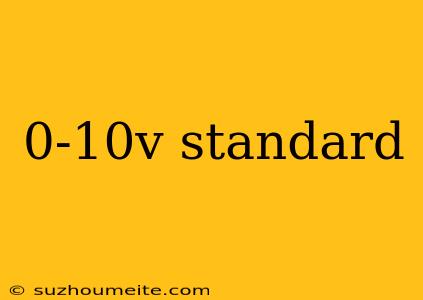0-10V Standard: Understanding the Basics
The 0-10V standard is a widely used analog signaling standard in industrial control systems, building automation, and process control applications. It is a simple, yet effective way to transmit analog signals between devices, and is commonly used in applications where precise control is required.
What is the 0-10V Standard?
The 0-10V standard is an analog signaling standard that uses a voltage range of 0 to 10 volts to represent a specific range of values. The standard is typically used to transmit analog signals between devices, such as sensors, transmitters, and controllers.
In the 0-10V standard, the voltage level is directly proportional to the measured value or setpoint. For example, a sensor that measures temperature may output a voltage signal that ranges from 0V (representing 0°C) to 10V (representing 100°C).
How the 0-10V Standard Works
The 0-10V standard works by using a voltage source to drive a current through a load, such as a resistor or a transmitter. The voltage level is determined by the resistance of the load, and the current flowing through the load is proportional to the voltage level.
In a typical 0-10V system, the transmitter or sensor outputs a voltage signal that represents the measured value or setpoint. The signal is then transmitted to a controller or receiver, which interprets the voltage level and takes appropriate action.
Advantages of the 0-10V Standard
The 0-10V standard has several advantages that make it widely used in industrial control systems:
High Accuracy
The 0-10V standard allows for high accuracy and precision in signal transmission, making it ideal for applications where precise control is required.
Simple and Reliable
The 0-10V standard is a simple and reliable way to transmit analog signals, with fewer components required compared to other signaling standards.
Flexibility
The 0-10V standard can be used with a wide range of devices, including sensors, transmitters, and controllers.
Noise Immunity
The 0-10V standard is less susceptible to noise and electromagnetic interference (EMI) compared to other signaling standards.
Applications of the 0-10V Standard
The 0-10V standard is widely used in various applications, including:
Industrial Control Systems
The 0-10V standard is commonly used in industrial control systems to transmit analog signals between devices.
Building Automation
The 0-10V standard is used in building automation systems to control lighting, heating, and cooling systems.
Process Control
The 0-10V standard is used in process control applications to measure and control process variables such as temperature, pressure, and flow rate.
Conclusion
In conclusion, the 0-10V standard is a widely used analog signaling standard that offers high accuracy, simplicity, and reliability in industrial control systems, building automation, and process control applications. Its flexibility and noise immunity make it an ideal choice for applications where precise control is required.
